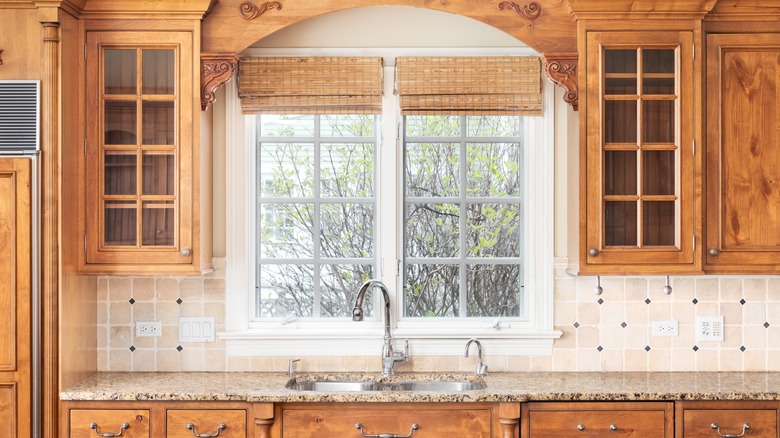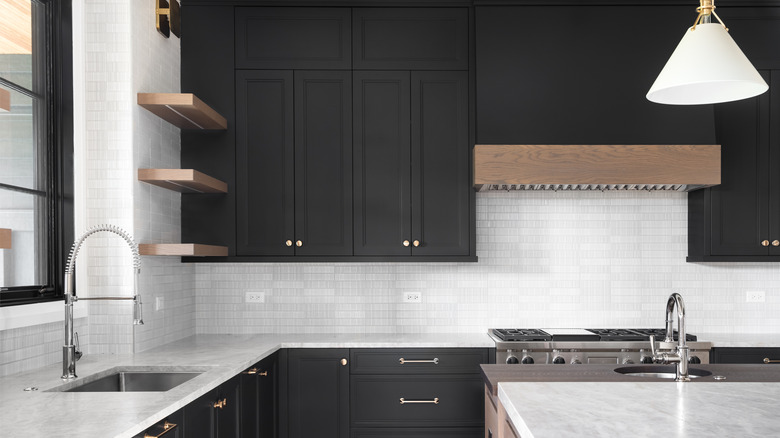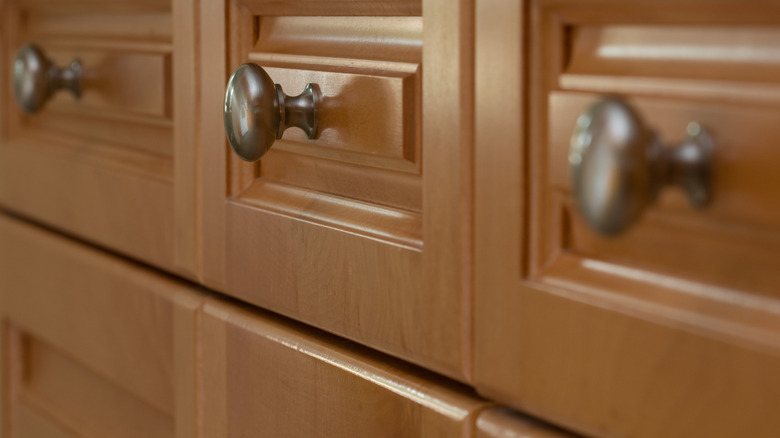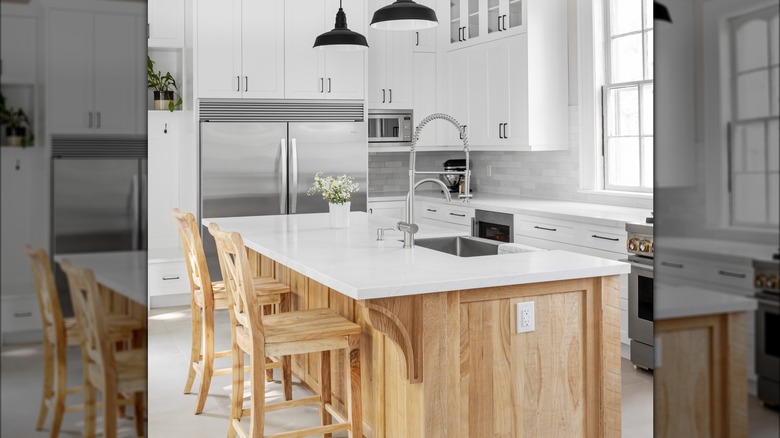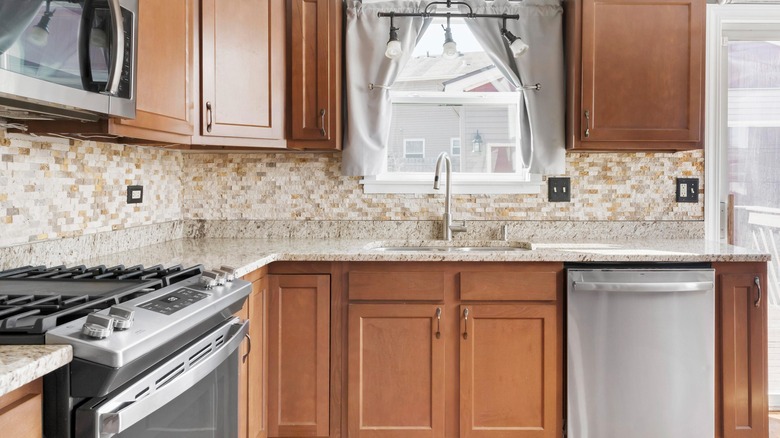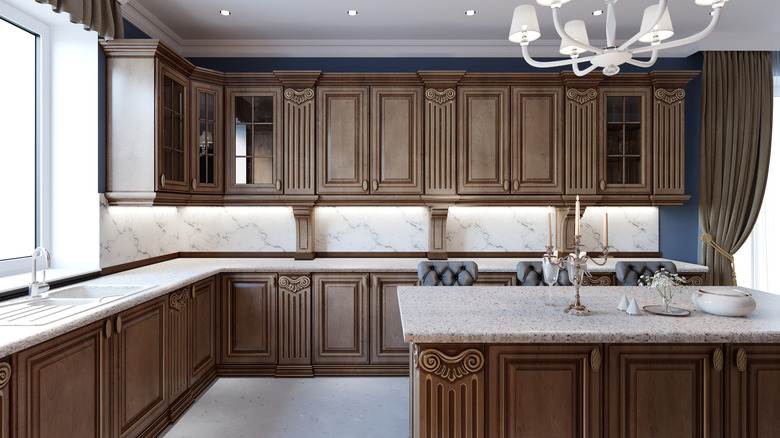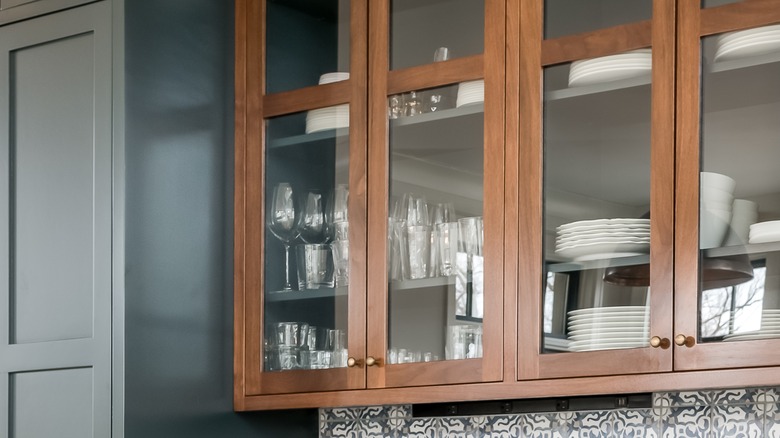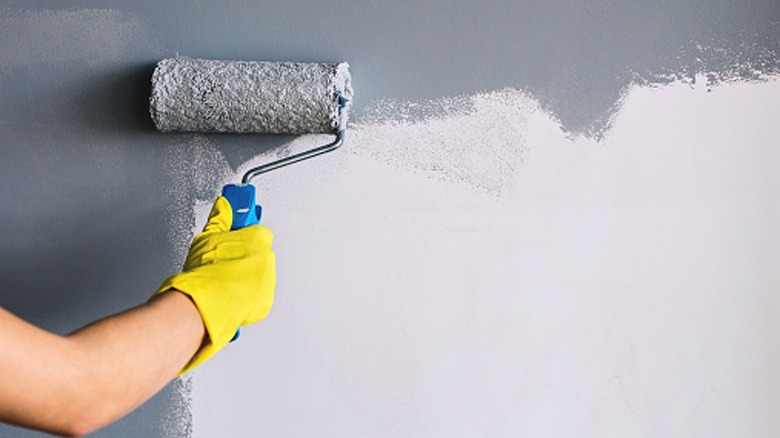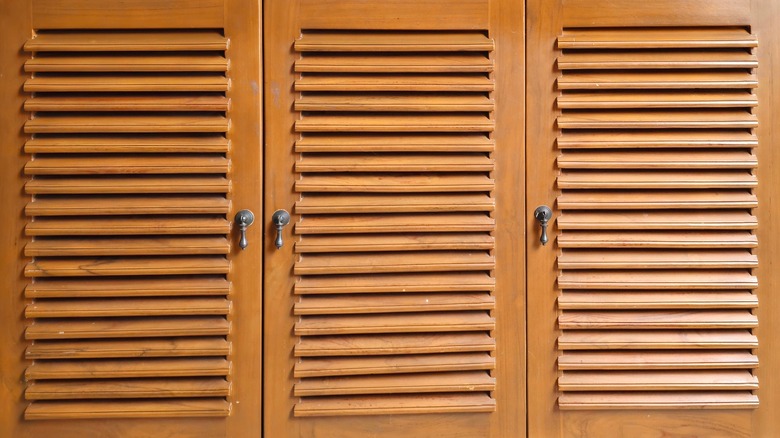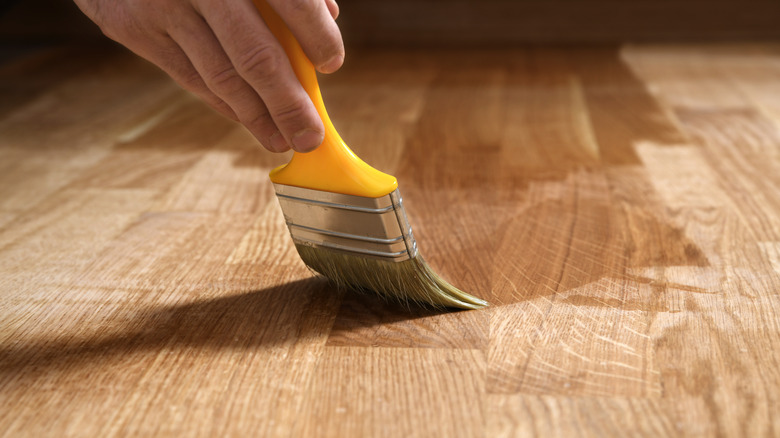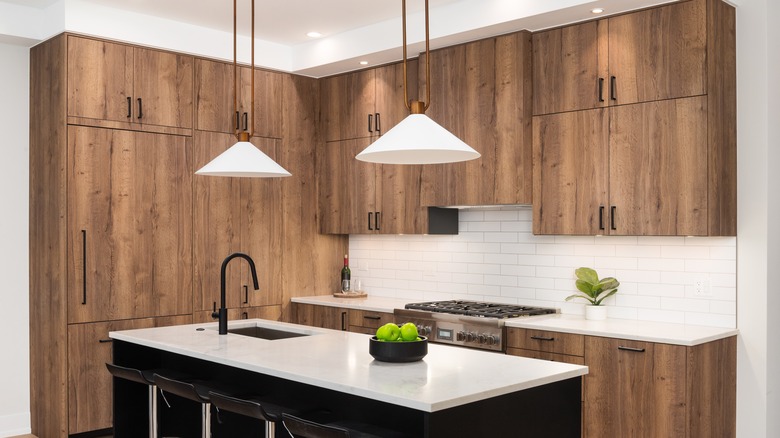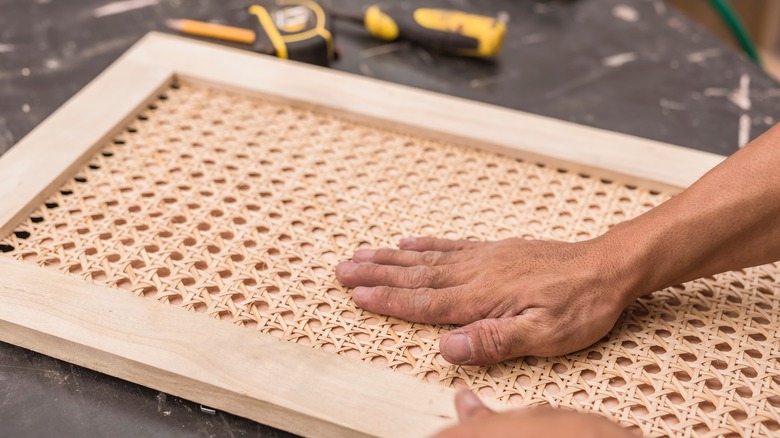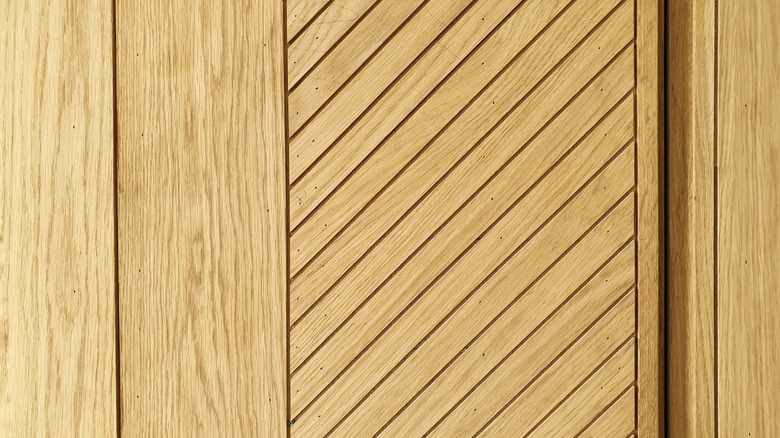13 Ways To Update Dated Honey-Toned Cabinets On A Budget
Cabinetry can be one of the most important elements in your kitchen. While you have a host of options today when designing or redesigning the space in your home, all too often older homes can come with less than spectacular cabinetry finishes, including the rather ubiquitous honey oak that plagued the 1990s and early 2000s in many new constructions. While once used to evoke warmth and coziness, today the oak can feel dated and drab, often with an unwanted orange cast to the wood that thwarts even your best attempts at creating a more updated look. While you can always install new cabinets if you have the time and budget for a full remodel, you may be looking for low-impact, cost-friendly alternatives to completely ditching them, including fully refinishing them, painting them, or just giving the cabinets a more contemporary glow-up in style.
Solid wood cabinets can be very desirable in older homes, largely since many manufactured abodes of the late 20th century often opted instead for manufactured materials with much less endurance. This means you may want to keep these durable cabinets, but still want to get a new look that doesn't scream turn of the millennia. Whether you want to leave them and find a way to live with outdated wood tones, or completely cover them up for the time being, we've rounded up a few great ideas for combatting their outdated look.
1. Paint
One of the most obvious and tried and true ways to update your cabinetry, painting cabinets can be a lot of work, but its definitely worth the result. Sand down your old honey oak cabinets to remove the finish, then prime them before painting. You can even paint wood veneer cabinets like a pro. While many people go with a classic white or off-white for brightness and the neutral background they provide, you can also opt for other stylish on-trend shades in today's kitchen design world, including rich dark shades of green, blue, and gray. For a bold choice that suits both rustic and modern kitchens, opt for a matte black.
2. New hardware
You can drastically change the look of existing or outdated cabinets by simply changing out knobs and pulls for something more in line with today's aesthetics. Many honey oak cabinets from the 1990s and 2000s have brushed silver or black hardware (or lack it altogether), so choosing other materials like nickel, brass, glass, or porcelain can make a big change. You can also swap out dated ornate handles or knobs for something more classic and streamlined. To keep a rustic vibe, switch out old hardware for classic cup pulls in antiqued silver or brass.
3. Tuxedo cabinets
If wall-to-wall honey oak cabinetry feels overwhelming but you still want the warmth of natural wood, consider a tuxedo or dual-colored kitchen. This style adds the lightness and brightness of a white kitchen up high, but grounds the room with rich wood below or only in selected areas like pantries or islands. The minimal use of honey oak still adds warmth to the room, but makes the kitchen feel more contemporary, where it works more as an accent than a major material, allowing you to mix in other woods and tones with equal weight.
4. Add trim
If you love the warmth and richness of honey oak as a material but hate your dated cabinets, consider adding some trim or molding to bring them into the new century. Many 1990s cabinets are builder grade with raised or recessed panels that instantly signify their age. If you cannot replace the doors entirely, consider flipping them around to take advantage of the flat back side, which you can leave as/is for a modern look, or add some similarly stained trim around the outside edge with wood glue to achieve a classic timeless Shaker cabinet look that is much more contemporary.
5. Restaining
Like painting, retaining cabinets fully takes a lot time and work, but you can give those outdated cabinets a completely new look on a budget if you go the DIY route. Sand and remove hardware, then apply the new stain. Opt for a more neutral or blonde finish, or go dramatically deeper with a dark walnut or mahogany finish. New stain will eliminate the orange tones of the oak and allow you greater flexibility in terms of color schemes in your kitchen. Stains with a blue cast are excellent for minimizing any orange or yellow tones in the wood.
6. New doors
Real wood cabinets can be a bonus in older and more custom homes, especially when many new constructions opt for manufactured materials. If you want to keep your original cabinet boxes, but hate the doors, you may want to refinish the casings and just replace the doors, which can give you the feel of an entirely new kitchen for a much more budget-friendly price tag. While you can always replace them with solid options that have a more contemporary design, consider replacing them with glass-paneled doors if you want a more open look.
7. Take off the doors
With many modern kitchens opting for open shelving, and easy way to update your outdated cabinets is to remove the doors entirely. Leaving them off creates a more contemporary open feeling, and allows you to get rid of door designs that feel too outdated. Just remove the doors and hardware and fill any holes with wood putty. This is a great option for renters who can always pop the cabinet doors back on when they move. The lack of doors minimizes the impact of existing honey oak compared to a solid wall of the material.
8. Paint your walls
If you have to leave the cabinets in their original finish, there are definite ways to minimize the orange cast of the existing cabinets by putting just the right coior on your walls. To make the cabinets stand out less, consider leaning into the warmth by painting your kitchen a rich terra cotta shade that will make the cabinets look more neutral in comparison. You can also paint the walls a more high contrast shade like deep charcoal gray that will change the way the cabinets read to more neutral in tone.
9. Louvered doors
If you want to give a more European or beachy look to your honey oak cabinets, whether your are keeping the finish or looking to cover it up, consider using wood trim in the same stain to add a faux louvered look of old shutters to the doors. The horizontal lines add texture and dimensions, as well as a more luxe custom look, to boring builder grade cabinet doors. Just use wood glue and finishing nails to add strips of inexpensive molding stained to match crosswise on the cabinets for an instant transformation.
10. Use a wood glaze
Wood glazes are a great alternative to stain. While a glaze does not penetrate the wood quite as deeply, it still offers a chance to change the look of an existing stain without having to remove it entirely. Most glazes can make a bit change if applied after minimal sanding. Glazes also tend to be more eco-friendly and less harsh to use inside, making them great if you cannot remove your cabinets to work on them outdoors. Since it's water based, it also smells better and is easier to clean up.
11. Peel-and-stick paper
If you want a quick transformation of your cabinets without removing them or replacing them to abolish the dated honey oak finish, you can use wood-look contact paper or peel-and-stick wallpaper to give them a new look. This can be more challenging to apply on cabinets with a lot of recesses, but works wonderfully on completely smooth doors. Just clean the surfaces fully and apply the adhesive paper, smoothing out the bubbles with a spatula and a hair dryer to apply heat. Automotive vinyl is also a great renter-friendly hack to cover up unsightly cabinets.
12. Rattan
For a chic and nature-inspired vibe, add some rattan to the front of inset cabinets for a completely different look. You can buy rolls of rattan material and apply it by wetting the material and stretching to fit before stapling in place. It's an accent that works well in more casual and boho-style kitchens, as well as French country inspired spaces. The woven material will lessen some of the impact of the honey oak finish, adding another layer of texture and making the kitchen feel airier and brighter than the wood alone.
13. Herringbone
A fresh trend that is at the same time very classic, herringbone is having a moment in design circles. There are numerous ingenious DIYs that allow you to augment plain or ugly cabinet doors with wood trim, popsicle sticks, or paint sticks in a herringbone pattern, many requiring only wood glue and finishing nails. The effect is very old European in style, and instantly adds more interest to flat doors. For an even richer luxe variation, vary the stain slightly lighter or darker on each piece for custom look.
